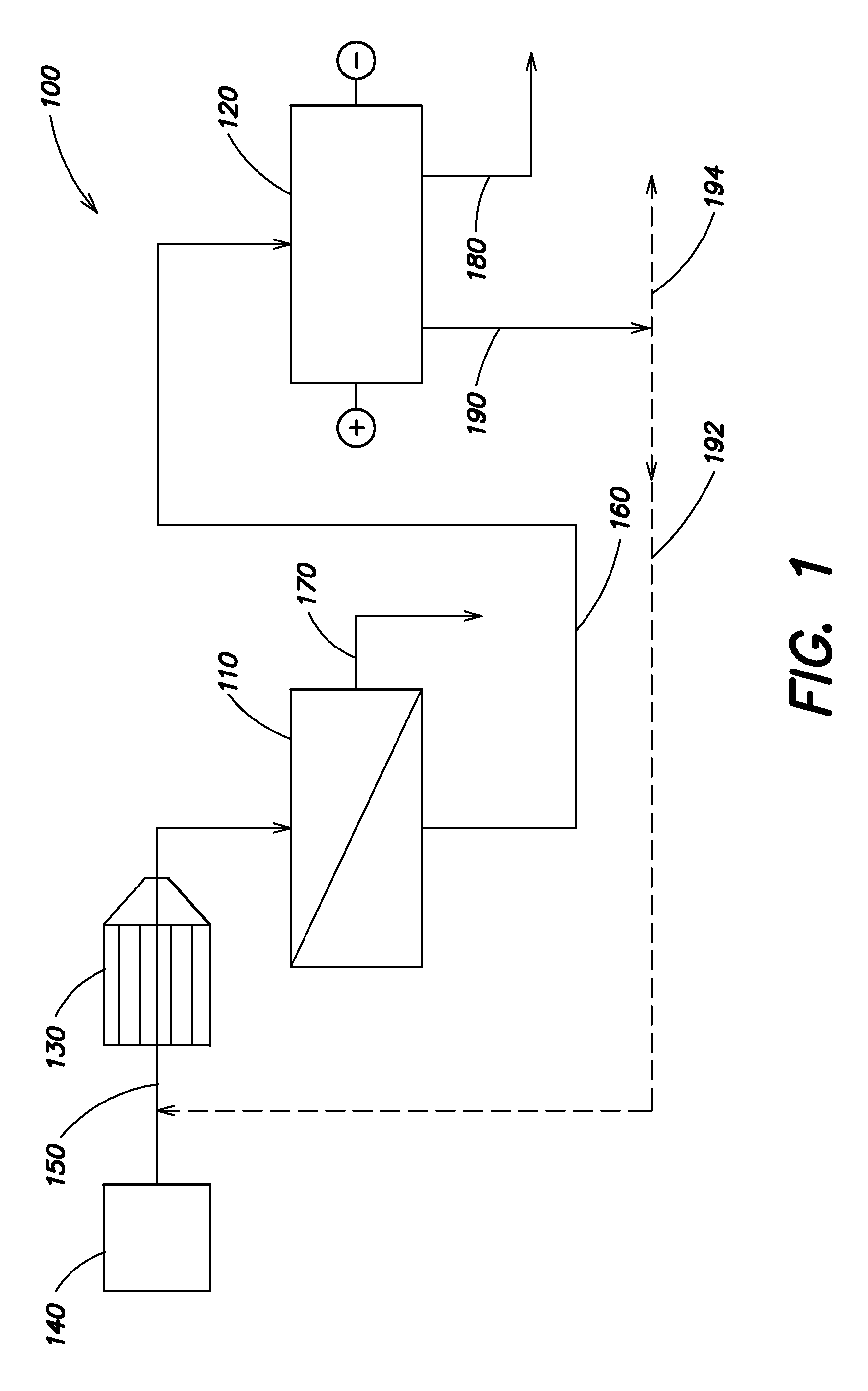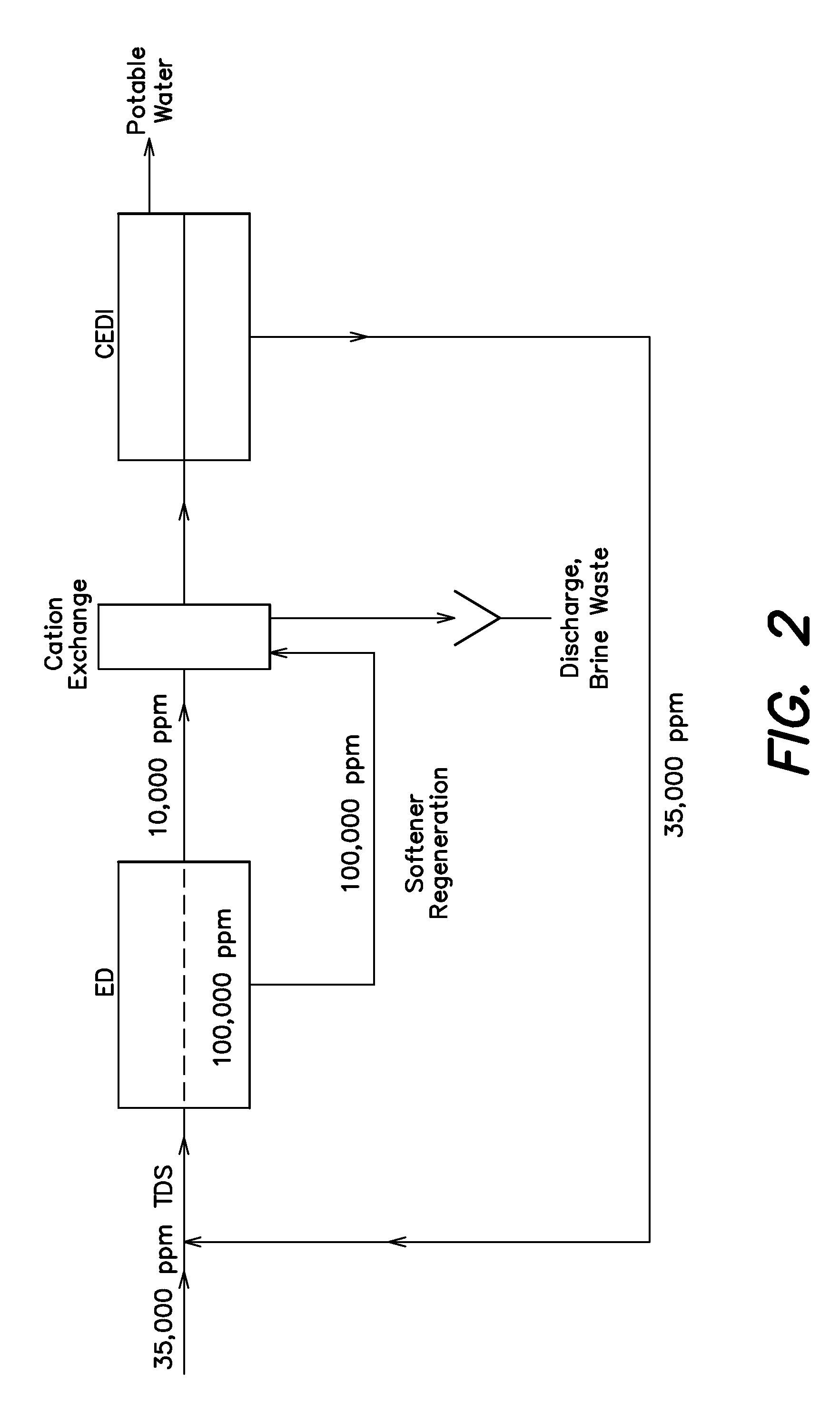Method and apparatus for desalination
a technology of desalination and water desalination chamber, which is applied in the direction of electrodialysis, water/sewage treatment by ion exchange, refrigeration components, etc., can solve the problems of energy cost prohibitive for drinking water conversion using present ro or distillation techniques, energy cost is the greatest continuing expense of desalination high salinity water, and achieves the effect of reducing total dissolved solids
- Summary
- Abstract
- Description
- Claims
- Application Information
AI Technical Summary
Benefits of technology
Problems solved by technology
Method used
Image
Examples
example 1
[0056]A comparison of state of the art RO-based systems with the systems and methods of the invention illustrate the energy savings that are achievable. A conventional RO-based system requires about 19.2 kwh / kgal to desalinate seawater as shown by the following calculations. In the calculations, the assumed trans-membrane pressure is about 900 psi, the assumed pump efficiency is about 85%, and the assumed water recovery is about 40%. Further, for an inlet flow rate of about 41.67 gpm, about 16.67 gpm of permeate and about 25 gpm of reject is produced. No energy recovery techniques are assumed to be utilized.
Brakehorsepower=(gpm)(psi)(1715)(eff)=(41.67)(900)(1715)(.85)=25.73bhp(19.2kw)
[0057]However, if energy recovery techniques are utilized, the calculated energy requirement can be reduced. Examples of energy recovery assemblies or techniques include, for example, a turbine, such as a Pelton wheel, or a pressure exchange device. Both types of devices can recover the energy from the ...
example 2
[0059]To estimate the amount of total energy required to desalinate seawater utilizing a system comprising a combination of nanofiltration and electrodeionization devices, the energy requirements for each are independently determined and then combined.
[0060]The energy requirement associated with the NF device is approximated to be about 10.7 kwh / kgal (about 2.8 kwh / M3) as shown by the following calculation.
Brakehorsepower=(gpm)(psi)(1715)(eff)=(41.67)(500)(1715)(0.85)=14.3bhp(10.7kw)
[0061]This estimate was derived by assuming that the trans-membrane pressure was about 500 psi, the pump efficiency was about 85% pump efficiency, and the water recovery was about 40%. This estimate was further based on an inlet flow rate of about 41.67 gpm, producing about 16.67 gpm of permeate and about 25 gpm of reject. No energy recovery techniques were utilized.
[0062]Energy techniques can also be utilized in nanofiltration devices in a manner similar to that described above with respect to RO-based ...
example 3
[0065]A system was operated to determine if seawater can be purified (desalinated) to a level of less than about 500 ppm TDS. The system was comprised of a nanofiltration device and CEDI devices that meets the above-mentioned energy requirement (less than about 3.8 kwh / kgal). Artificial seawater was prepared from INSTANT OCEAN® synthetic sea salt mix, available from Aquarium Systems, Mentor, Ohio.
[0066]The nanofiltration and CEDI devices were operated under the following conditions:
[0067]Closed loops were utilized for both nanofiltration and CEDI devices. Electrode compartment feed water for the CEDI device, which was separate from the nanofiltration product water, was made up from RO water, with H2SO4 added to achieve a pH of about 2. Feed water calcium content was approximately 50 mg / l, measured as CaCO3.
[0068]The nanofiltration device utilized a FILMTEC® NF90 (4×40) membrane, available from The Dow Chemical Company, Midland, Mich. The inlet water stream into the nanofiltration de...
PUM
| Property | Measurement | Unit |
|---|---|---|
| pressure | aaaaa | aaaaa |
| thickness | aaaaa | aaaaa |
| pressures | aaaaa | aaaaa |
Abstract
Description
Claims
Application Information
 Login to View More
Login to View More - R&D
- Intellectual Property
- Life Sciences
- Materials
- Tech Scout
- Unparalleled Data Quality
- Higher Quality Content
- 60% Fewer Hallucinations
Browse by: Latest US Patents, China's latest patents, Technical Efficacy Thesaurus, Application Domain, Technology Topic, Popular Technical Reports.
© 2025 PatSnap. All rights reserved.Legal|Privacy policy|Modern Slavery Act Transparency Statement|Sitemap|About US| Contact US: help@patsnap.com



